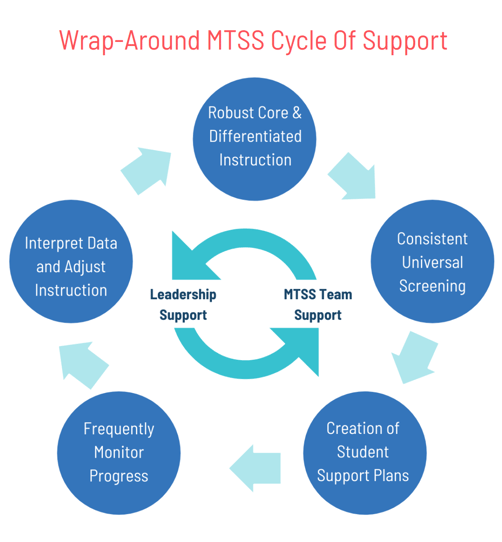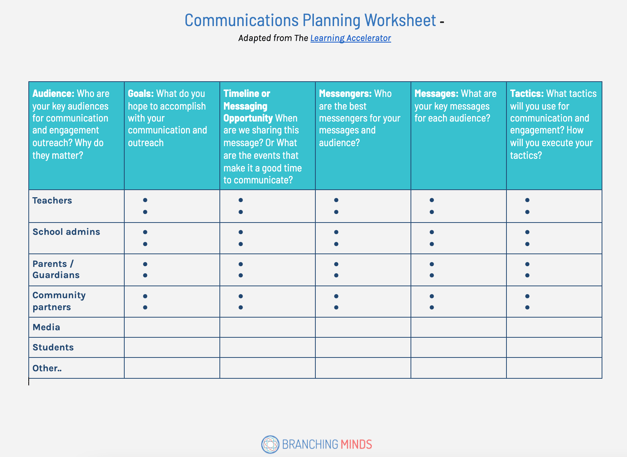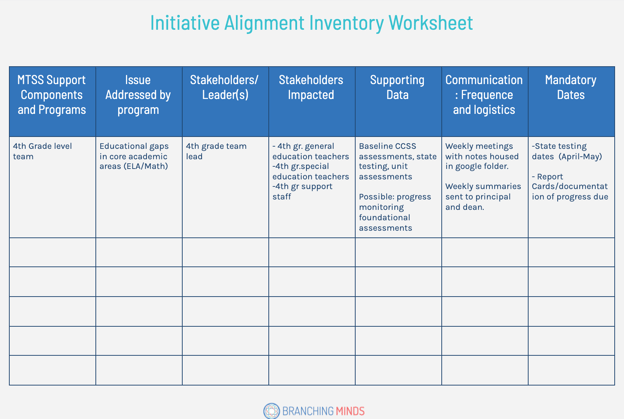Winning the MTSS Tug-Of-War -- How to Create Infrastructural Alignment for MTSS
There is a universal truth when starting any sort of new project, vision, implementation, or system change: a disruption and reallocation of time and resources must be addressed. With the addition of a new goal, there will be a back and forth battle as finite (time, staffing, money) resources are reassigned. To minimize or alleviate the exhaustion that accompanies the tug-of-war, alignment should be the goal of every leader.
An overlooked, yet vital step in setting the stage for successful Multi-tiered Systems of Support (MTSS) foundations is alignment. The clarity that the alignment process brings, offers a path to maximize overall effectiveness, both within the MTSS adoption itself, as well as its integration with schoolwide functionality. The objective of bringing resources to help every student meet their goals is most successful when schools have aligned the multiple layers of resources and programs that schools employ to support their students. Alignment, by definition, considers movement in a straight line, which we all know is the shortest distance between two points. Alignment can also be seen as holding and honoring positions of agreement; arguably the most effective way to implement any systemic change, including moving forward with consent from all parties. Each of us has had opportunities to reap the benefits when multiple factors are working in alignment in life and/or work. Whether it's the car tires or a relationship, the alignment of numerous flexible parts is critical. As humans, and specifically as educators, we are profoundly aware of the frustration, and of feeling the lack of adequate progress, when alignment is not overtly tackled and communicated.
When there is a successful adoption of MTSS, each component cohesively works in a symphony; the universal pre-screen is administered and analyzed, needs analysis are completed and utilized, student strengths and growth edges are assessed, data is used to create interventions, support plans are delivered, and progress monitored with fidelity and finally plan adjustments are made to achieve success for students. When there is complete alignment, all the parties involved benefit, including the student, school community, and all initiative stakeholders.
Ultimately, the following benefits are derived:
- Prioritization of the success of all students, both individually and as a community of learners; academically, behaviorally, and emotionally.
- A boost in stakeholder time by streamlining processes and prevention of duplication of services.
- Filling existing academic gaps and strengthening existing educational programs.
Each year, school campuses and districts are tasked with implementing several initiatives and programs, MTSS included, all with the student’s and staff’s best interests in mind. By nature of its design, MTSS can serve as the ultimate problem-solving and communication path for a campus when the time and energy is spent first to align the MTSS principles with existing school programs and initiatives. Although this may feel overwhelming, using MTSS as a catalyst and a guide for alignment can be a positive, and ultimately incredibly valuable process.
➡️ Related Resouce: Making the Case that RTI/MTSS is NOT Just Something Extra
Here are some tried and tested steps to launch the alignment of MTSS at the school and district level:
-
Name the Resistance
A popular phrase is often used in the Social and Emotional Learning (SEL) world that we can easily apply here: “name it to tame it.” This phrase coined by Dr. Dan Siegel, is often used to identify strong emotions which arise. Sometimes these strong emotions possess the power to impede one's ability to engage with their best work. When considering systems work, as the phrase implies, once resistance and obstacles are named, solutions and workarounds can be identified and utilized. If MTSS and leadership teams can name the barriers to implementation, then and only then are viable solutions able to come to the table with objectivity. Once barriers to implementation are called out, it is much easier to identify, or tame, which ones have immediate answers, as well as plan for those that are a bit more challenging. Looking at further implementation barriers, some boundaries might require collaboration and partnership, which could require additional collective guidance, leadership, and academic support. Once the implementation impediments are named, identified, and categorized, the first step of reducing the tug of war has begun. Schools can then be on their journey to alignment.
-
Create a Plan
With planning, communication and a vision, MTSS can be implemented within the school and district successfully, without feeling like it competes with other numerous school initiatives.

When considering a plan, begin by ensuring that the MTSS components include the following:
- Robust core curriculum and differentiated instruction that meets the needs of 80% or more of students;
- The use of valid and reliable universal screeners for all students;
- The creation of student support plans based upon universal screening data;
- The frequent use of reliable progress monitoring;
- The creation of "student support/decision teams" to consistently review student progress and make adjustments to the duration and intensity of planned intervention, based upon data; and
- The support from leadership to provide frequent and clear messaging, professional development for staff, time for teachers to collaborate, and other needed resources to ensure MTSS is successful.
Each of these areas build the foundation of a strong multi-tiered support system. When planning for the implementation of MTSS, trending to and monitoring the celebrations and concerns of each of these areas is essentially the alignment of MTSS.
When planning, MTSS is the foundation that multiple programs and supports are housed. As the MTSS components listed above are designed and implemented, it’s important to look with a school-wide lens to embrace and understand the depth of alignment.
-
Identify and name all school efforts, programs, and processes
As mentioned before, schools and districts are chock-full of programs, initiatives, processes, and services available and designed to support students in specific areas. These could include enrichment programs, STEAM opportunities, mentorship, character development, behavioral support, or even particular arts programming. In addition, the opportunities available to schools made possible through donors, grants, scholarships, and passion projects are endless and every school-specific.
Begin by identifying all the school-wide services and initiatives on the campus. The more specificity the list can offer, the more potential for future alignment. An inventory of initiatives can give voice to those small yet powerful groups with student academic, social, and behavioral impact. This step also organically allows for alignment/nonalignment to be easily revealed. Ultimately, an initiative inventory is a best practice to know what's happening and its impact on students at any school or district. Also, when we think about Multi-Tiered Systems of Support, an initiative inventory is the only way to begin checking for alignment to know how to best support students without exhausting staff later down the road.
As the inventory is taking shape, begin to notice patterns that could eliminate resource depletion later. For example, are there two groups that have similar functions and outcomes? Is there a way for these groups to co-create something to support students while coordinating staffing and time resources? Does the school have multiple academic interventions, and lack social skills groups? Are all subgroups of students represented and have access to all programs? An initiative inventory can surface valuable information when making sure that the right supports are in place and accessible for students to achieve maximum benefits.
-
Identify the stakeholders
Each initiative and group in a school or district has a primary stakeholder; someone in the school community who has spearheaded an initiative. Another individual might be an active supporter, identified by their passion and expertise. Each stakeholder has a lens, and all are deeply concerned about moving the goals and objectives forward. The stakeholders and leads know how this program/group will impact student outcomes and are working to implement with fidelity in service of student growth. For each existing initiative, meetings have taken place, and a vision has been established. Knowing the stakeholders, leaders, and the lens through which they look when unpacking the nuts and bolts of alignment is gold. After stakeholders/leads are identified, begin naming the team members, and the roles, responsibilities, and the lens of each. As the inventory is completed, alignment is accomplished when team members know and embody their roles, responsibilities, and success criteria for the teams on which they serve.
➡️ Learn more about successful MTSS team functions: Developing a Successful MTSS/RTI Team
-
Align assessment and other required data
Schools are up to their eyeballs in data. The tricky part of achieving alignment is knowing what data to use and employing chosen data best to drive the most impactful decisions. An alignment inventory of initiatives to support MTSS adoption can help. Start by identifying the why of the data. Data that doesn't have a purpose of supporting students can feel like extra work or even irrelevant. Knowing what data is collected, communicating about the usage, and reflecting on the process will increase buy-in and empowerment when using the data to inform academic and school-based decisions. -
Communicate concisely, and more often than you think necessary
Communication is critical, and aligned communication will get MTSS where it needs to be. With each initiative, spend time on creating a communication plan, beginning by examining the communication systems that your schools use. Schools are great places where mass communication is experimented with, whether email, text, slack, announcements or mailbox notes. What is the primary way in which information is expressed to all staff members? Let's not forget that the best forms of communication will be received by all, making it a necessity to communicate in multiple modalities. When communicating about services or students, having clear information in numerous formats is essential for adult learners.
When reviewing the communication plan, an important step is to be aware of the established point people. For example, there might be someone whose motivation is compliance, whereas for someone else it’s passion. Each serves a vital role, and both will communicate importantly and also vastly different points. Value each communication, and make sure that the message is clear from multiple perspectives. Finally, make sure that recipients of communication are inclusive yet intentional. When looking at the alignment table, think about what needs to shift to allow precise and streamlined communication.

-
Organize!
Schools have a natural ebb and flow of timing. While never slow, once the school year has settled in, there is a greater chance of automaticity. Staff are familiar with the bustle and exhaustion associated with starting and closing a traditional school year. While holding the school calendar loosely, what other significant dates will take precedence for each initiative? Where are the times when initiatives can be re-evaluated for alignment, and when will they add an unbearable workload on staff? Using the district calendar and the upcoming initiative dates is a critical step to support alignment and eliminate a tug of war situation.
Moving teams, schools, and districts forward in an aligned, straightforward manner is critical to ensure the success of your MTSS implementation. Having the insight to intentionally examine, adjust, and communicate so that all parties are informed and working in the same direction will increase MTSS sustainability and implementation. This task might feel daunting at first, yet it is manageable and necessary to complete the invisible work, avoid power struggles, miscommunications, or even system failure. Alignment of initiatives and MTSS programs is the foundational work for schools, and can preemptively eliminate the tug of war between time, financial resources, and staffing allocations. Ultimately, completing an alignment inventory sets up your MTSS systemic change, and all the people involved, for success.
Interested in Learning About Branching Minds?Branching Minds is an MTSS/RTI system-level education platform that brings together innovative, easy-to-use technology with the latest insights from the learning sciences to help drive student and school success while making teachers and administrators work easier and more effective. Branching Minds connects data, systems, interventions, and stakeholders so that educators, administrators, and families can work better together to support students' holistic needs.
|
About the author
[Guest Author] Rebecca Rosher

Your MTSS Transformation Starts Here
Enhance your MTSS process. Book a Branching Minds demo today.


















.png?width=716&height=522&name=Tech-Learning-Most-Influential-Edtech-Product-2025(preview).png)
